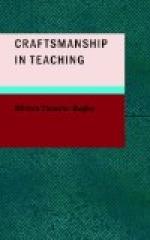V
A third general method of improving the efficiency of teaching is to build up the notion of responsibility for results. The teacher must not only take the message and deliver it to Garcia, or to some other individual as definite and tangible, but he must also bring the answer. So far as I know there is no other way to insure a maximum of efficiency than to demand certain results and to hold the individual responsible for gaining these results. The present standards of the teaching craft are less rigorous than they should be in this respect. We need a craft spirit that will judge every man impartially by his work, not by secondary criteria. You remember Finlayson in Kipling’s Bridge Builders, and the agony with which he watched the waters of the Ganges tearing away at the caissons of his new bridge. A vital question of Finlayson’s life was to be answered by the success or failure of those caissons to resist the flood. If they should yield, it meant not only the wreck of the bridge, but the wreck of his career; for, as Kipling says, “Government might listen, perhaps, but his own kind would judge him by his bridge as that stood or fell.”
President Hall has said that one of the last sentiments to be developed in human nature is “the sense of responsibility, which is one of the highest and most complex psychic qualities.” How to develop this sentiment of responsibility is one of the most pressing problems of education. And the problem is especially pressing in those departments of education that train for social service. To engender in the young teacher an effective prejudice against scamped work, against the making of excuses, against the seductive allurements of ease and comfort and the lines of least resistance is one of the most important duties that is laid upon the normal school, the training school, and the teachers’ college. To do well the work that has been set for him to do should be the highest ambition of every worker, the ambition to which all other ambitions and desires are secondary and subordinate. Pride in the mastery of the technique of one’s calling is the most wholesome and helpful sort of pride that a man can indulge in. The joy of doing each day’s work in the best possible manner is the keenest joy of life. But this pride and this joy do not come at the outset. Like all other good things of life, they come only as the result of effort and struggle and strenuous self-discipline and dogged perseverance.




